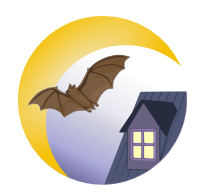Although white-nose syndrome is currently the greatest threat to bats in Canada, they are also subject to other stressors. These stressors include habitat loss, disturbance as a result of anthropogenic activities. Pesticides and wind turbines also have a negative impact on bat populations of eastern Canada.
Habitat loss and fragmentation

Bats in Canada live primarily in forested areas (coniferous and/or deciduous forests) and they hunt close to small and large bodies of water (ponds, rivers and lakes). Habitat modification, caused by urban development, deforestation and agriculture, affects bats. These activities, among others, decrease the number of stumps and mature trees, which provide suitable roost sites, and also decrease the abundance of humid areas. Consequently, bats using these forests can have trouble finding adequate sites to roost, and the size of their hunting grounds is also reduced. Protecting and conserving forested zones that border bodies of water is important as these are ideal habitats for bats.
Some studies show that creating small openings in the forest can provide foraging areas and orientation points for bats (Grindal and Brigham 1998). Therefore, with appropriate management of logging by the forestry industry, it is possible to maintain adequate habitat for bats.
Disturbances in hibernacula

In order to reduce energy expenditure during the winter, bats lower their body temperature during hibernation. To do this, they take refuge in roosts called hibernacula (abandoned mines, crevasses or caves that allow them to maintain these low body temperatures). During this critical period of the year, bats are very sensitive to changes in temperature, lighting and noises.
Visiting caves during the hibernation period can be detrimental to bats as the presence of humans may trigger unnecessary arousals. During hibernation, it is normal for bats to wake up about once a month to drink water and urinate. A single arousal can cost a bat 30-60 days of energy reserves! The more often a bat wakes up from hibernation, the less energy remains for them to survive winter. If they do not have enough energy, they will die of hunger and dehydration. In addition to having a lower body temperature during hibernation, bats’ immune systems are weak, which makes them more susceptible to infection and diseases. It is therefore strongly advised not to visit caves inhabited by bats during the winter.
Removing bats from a maternity colony
During the summer, bats aggregate in maternity colonies to give birth to young and to nurse them. Maternity colonies are generally located in areas where heat accumulates, such as in attics, walls of homes, or in chimneys. These sites are essential to bat reproduction, and their preservation is important.
When a maternity colony is found in an inhabited building, sharing this space with bats may be difficult. Nevertheless, it is important not to remove the bats, if at all possible, during their reproductive season. During this time, some of the young will not yet be able to fly, and as a result could become trapped in the walls. This could cause other problems such as unpleasant odours if the bats die there. It is possible to remove bats from a building in April and May, before the young are born, or between September and October, as the colony is dispersing. Once the entrances are blocked, you can install a bat house if you would like bats to continue living on your property.
If you must remove a colony, you can do this by following these guidelines. It is generally recommended that you make repairs in September or October because bats will typically leave maternity colonies at the end of August. To learn how to better coexist with bats, please refer to the following section "Living in harmony with a bat maternity colony".
Pesticides
Since bats feed on insects, they are highly susceptible to the effects of pesticides. Pesticides not only reduce the availability of insect prey for bats, but may also cause sickness or death when bats ingest contaminated insects. As these products are stored in the fatty tissues of the animal, the body assimilates insecticides during hibernation. Insecticides have also been found in the breast milk of bats. Both migratory or non-migratory bats are susceptible to the negative effects of insecticides.
Wind Turbines

All species of bats are susceptible to mortality from wind turbines, however migratory species are the most at risk. Wind turbines can cause death to bats not only through direct collisions but also due to pressure changes as bats fly through them. Dramatic changes in pressure can results in internal trauma and hemorrhaging in the lungs. Barotrauma from wind turbines is a significant threat to certain migratory species.

